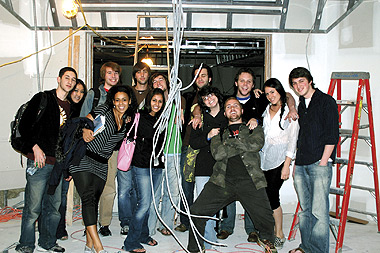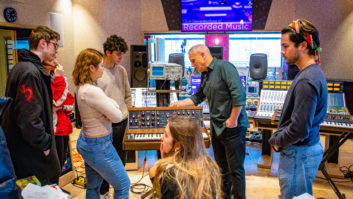
A group of Clive Davis Department of Recorded Music’s future hitmakers pose in Studio 510’s control room during construction.
In February of 2003, the Tisch School of the Arts at New York University (www.nyu.edu/tisch/) received a $5 million donation from industry icon Clive Davis to create a new Clive Davis Department of Recorded Music. The four-year, intensive B.F.A. program is limited to 28 students a year and focuses on music recording as both a creative medium and a complex business enterprise; pupils are expected to master both aspects of the industry.
The curriculum includes studies on the cultural impact of recorded music and the history of different musical genres, including rock, pop, hip hop, jazz, Latin and world music. A major part of the program centers around recording studio practices, and the school opened with Studio 505, a small room equipped with an SSL K Series console.
With its emphasis on production, the school looked to expand its facilities, and the demolition of a half-floor of office spaces began in August 2005 to make way for the state-of-the-art Studio 510. The construction and demo work could have been scheduled to occur during holidays and off-periods, but department chair Jim Anderson felt that “observing every phase of facility construction offered the students a rare learning opportunity.”
The centerpiece of Studio 510 is a 48-frame, 32-channel API Vision surround console. One of the factors in the console choice was “to get that classic API sound in a 5.1 console,” according to Anderson. However, selecting an analog console was another key ingredient. “Teaching serious audio flow requires an analog console. We bucked the digital trend and went analog, which we felt is how people learn,” Anderson explains. “For NYU, the API Vision console will be a remarkable teaching tool. This board will be around for a long time, and this was our only chance to do it right.” Keeping all options available, a massive TT patchbay links the Vision to a Studer A827 analog 24-track in the adjacent machine room and to a full-blown Pro Tools HD rig.
The studio has a large (850-square-foot) recording space that can accommodate 35 musicians or can double as a lecture space. The cavernous control room is 27 feet front-to-back and has a rear seating area for 28 students. The project offered plenty of challenges to studio designer Sam Berkow of New York’s SIA Acoustics, especially considering the studio location: in the heart of New York City, in an occupied former manufacturing plant. Achieving isolation in such cases can be difficult, especially with offices and classrooms above and below the studio.
The floating floors are a complex six-layer sandwich of Kinetics RIM with Fiberglas pucks/plywood/Kinetics honeycomb SR board/plywood/cement board/plywood. The studio floors boast a final layer of cherry wood with large inset slate panels, allowing for choices in recording surfaces. “I’m a fan of hard, not mushy surfaces,” says Berkow, “so we used slate flooring. You can always cover it with a rug if you want it softer, but slate is amazing — particularly for drums.” Additionally, swing-out wall panels along the side open to expose RPG diffusors for more variation. Acoustical cloth covers the ceiling, which hides RPG Flutter-Free panels that provide echo control and bass absorption.
“Everyone that sees the room says, ‘Wow,’” Anderson enthuses. “This is how studios used to be built.”
The spacious control room has an asymmetrical design with an alcove area to the left of the mix position that doubles as a bass trap. The room’s rear corners are angled at 60 and 30 degrees, eliminating bass buildup and allowing space behind the wall for ductwork. In a room filled with 30 or more occupants — each generating the heat equivalent of an 80-watt lightbulb — air flow is critical, and Studio 510’s large-diameter ducting offers sufficient heat control without adding handling noise.
In keeping with the classroom theme, the control room has four soffit-mounted 42-inch flat screens that can show video or DAW displays with excellent sight lines to all seated positions. Audio playback is emphasized by a PMC surround system with five MB2 monitors driven by Bryston 14B amps. “You need a lot of audio to fill a room of that size,” says Anderson.
“It’s much larger than the normal listening area,” adds Berkow, “and creating a listening environment that works for the mixer and the students in the rear of the room was quite a design challenge.” One of Berkow’s solutions was to angle the studio window so that the multiple panes of glass form a wider triangle at the bottom — the opposite of the typical inverted-triangle method. “This reduces reflections from off-axis sound from the front speakers, as well as from the rear surround speakers by bouncing any sounds upward toward the absorptive ceiling,” Berkow explains.
Since the room opened in September 2006, reaction has been overwhelmingly positive, from both students and staff. “The room reflects the program’s exciting and accessible environment for sessions and teaching,” Anderson says. “With the department’s focus on contemporary music, we look forward to the variety of projects that our new studio and new console will attract within the university.”
George Petersen is Mix’s executive editor.







